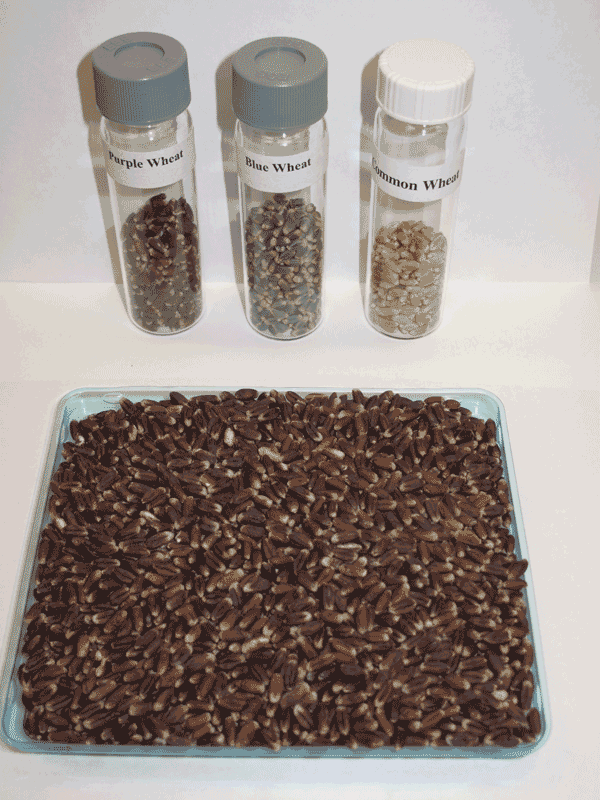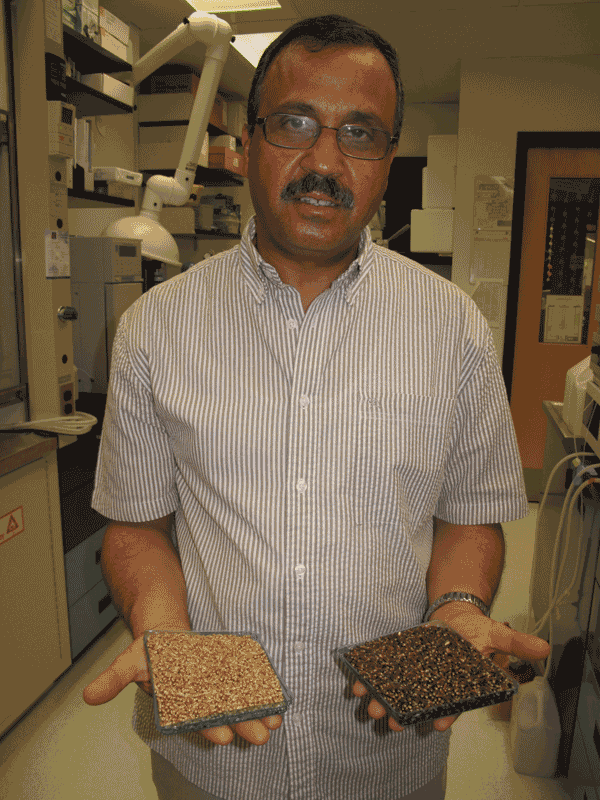The advantage of purple
HOW ONE WHEAT VARIETY IS SHADES ABOVE THE REST
consider all the great research being done worldwide to improve grain crops and a wheat breeding program focused on kernel colour might seem somewhat absurd. But science shows colour counts – and the purple researchers are producing today could mean more green for farmers tomorrow.
Many studies show there’s more to food than calories, and food scientists at Agriculture and Agri-Food Canada (AAFC) are working to identify the full potential of coloured wheat varieties for improving consumer health and farm wealth. Recent findings suggest that the blue and purple pigments contained in coloured grain kernels offer high levels of anthocyanins, the naturally occurring antioxidants most famously found in blueberries. Dr. Elaysed Abdelaal is a research scientist at AAFC’s Guelph Food Research Centre who says we’re continuously learning more about food; and in addition to the basic protein and energy we get, there are also a lot of other bioactive compounds to consider. As someone who’s studied anthocyanins for years, he’s very excited about what he sees in some newly developed wheat varieties from Saskatoon.
“Trying to understand the characteristics of anthocyanins, I expanded to not only purple wheat but also black barley and coloured corn,” said Abdelaal. “But the types of anthocyanin compounds are not the same in blue wheat as blue corn, for example, and in purple wheat some other pigments are dominant.”
breeding it blue
This increased ease of genetic inheritance is hugely beneficial to the traditional breeders developing purple wheat varieties at the University of Saskatchewan’s Crop Development Centre. After several years of work, a team led by Dr. Pierre Hucl has managed to adapt two lines of spring wheat. The kernels these plants produce boast purple pericarps on the outside and a layer of blue aleurone underneath. These are intensely scrutinized for several characteristics, including anthocyanin concentrations which increase rapidly during grain development and then decrease before maturity. These plants appear to be no different than any red or white variety during the growing season, but once harvest activities start, the colour becomes unmistakable.

The fact that these pigments, and therefore the anthocyanins, are heavily concentrated toward the outside of the wheat kernel is an incredibly important factor everyone involved has to consider according to Dr. Abdelaal. First of all, as a raw food ingredient, there is more value gained in using the wheat bran than the full kernel as antioxidant sources. Total anthocyanins averaged 157 mg/kg in blue wheat whole meal, but the blue wheat bran alone contained 458 mg/kg. Dr. Abdelaal says this limits the potential end uses in food production and for other purposes, it means additional processing to separate the kernel’s interior from the pigment rich exterior. In his research, Dr. Abdelaal focuses on addressing both of these problems.
“There are a number of pigments in the product, so we try to identify them, characterize them and see the potential health benefit,” said Abdelaal. “The second goal is to develop a process to isolate the pigments, which in pure form, could be a value-added component used for non-food applications like in the cosmetic industry.”
anthocyanins for health and beauty
Demands for anthocyanin-rich foods and supplements are steadily increasing due to the significant role these components play in human health and food colouration. As part of the antioxidant family, anthocyanins are thought to protect cells from the effects of oxidation and reduces the risk of many chronic diseases such as cancer, heart disease and type two diabetes. Some research also suggests anthocyanins can improve ocular health as well says Dr. Abdelaal. Simply by substituting purple wheat bran into the average baked good, consumers gain a significant bonus in health components such as antioxidants and fiber from their food.

“Anthocyanins could be added to a muffin, for example, really boosting the antioxidant capacity, vitamins and would give it good colour as well,” said Abdelaal. “The ultimate goal is to have well balanced food products that contain some health benefit.”
Compared to traditional anthocyanin sources such as red cabbage (250 mg/kg of anthocyanins) or plums (20-250 mg/kg), blue or purple wheat bran is a highly attractive option (458-495 mg/kg). To increase the concentration further, Dr. Abdelaal used a dry milling process to fraction the bran and produce anthocyanin concentrations that were over two times greater than whole grain. He has also found the wheat anthocyanins were significantly more extractable in ethanol than in water, and once extracted, can be partially purified into a highly concentrated powder that averages 3378 mg/100 g. Dr. Abdelaal says, with the various processing options, there is a greater opportunity for product development and access to a wider variety of markets.
“We try to have a variety of products made from purple wheat for different applications and try to consider the cost of each of these products with the application,” said Abdelaal. “But because anthocyanins are antioxidants, it can prolong the stability of the product over time in addition to adding health benefits.”
Dr. Abdelaal says he looks forward to further investigating how anthocyanins could extend the shelf life of both cosmetic and food products. There is still more research to be done with regards to the cosmetic applications of purple wheat derived pigments but Dr. Abdelaal says there is potential the anthocyanins in these products could be absorbed by the body while worn, something he suspects will be of interest to both processors and consumers alike. •







